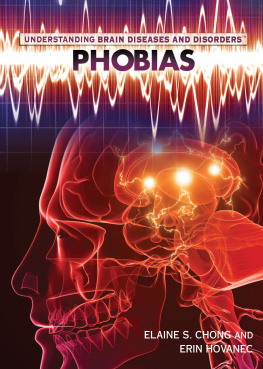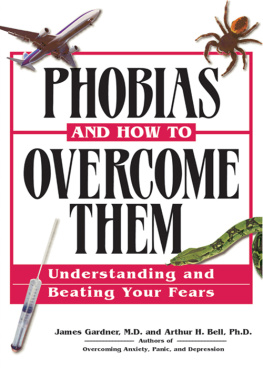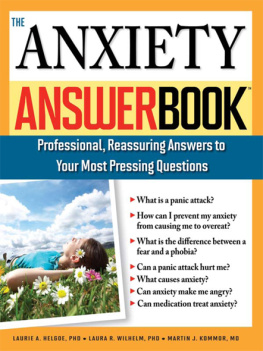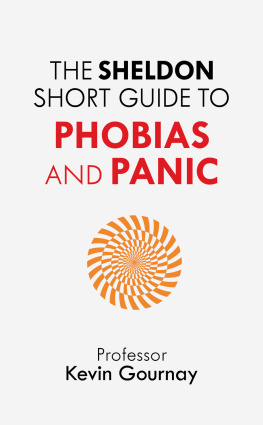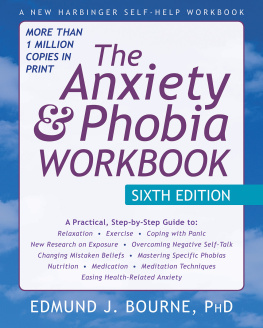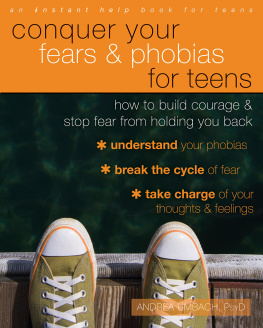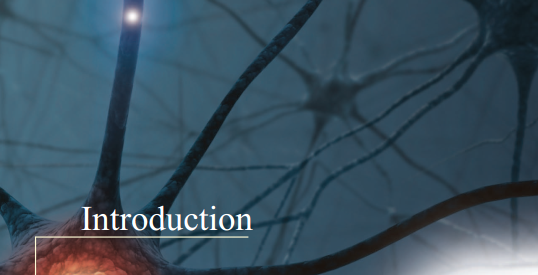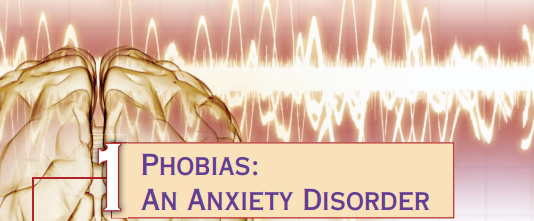Published in 2012 by The Rosen Publishing Group, Inc.
29 East 21st Street, New York, NY 10010
Copyright 2012 by The Rosen Publishing Group, Inc.
First Edition
All rights reserved. No part of this book may be reproduced in any form without permission in writing from the publisher, except by a reviewer.
Library of Congress Cataloging-in-Publication Data
Chong, Elaine S.
Phobias/Elaine S. Chong and Erin Hovanec. 1st ed.
p. cm.(Understanding brain diseases and disorders) Includes bibliographical references and index.
ISBN 978-1-4488-5541-4 (library binding)
1. PhobiasJuvenile literature. I. Hovanec, Erin M. II. Title. RC535.C46 2012 616.85'225dc23
2011019965
Manufactured in China
CPSIA Compliance Information: Batch #W12YA: For further information, contact Rosen Publishing, New York, New York, at 1-800-237-9932.
CONTENTS
CHAPTER 1
Phobias: An Anxiety Disorder
CHAPTER 2
A Variety of Explanations
CHAPTER 3
Professional Treatment for Phobias
CHAPTER 4
Managing Everyday Fearsand Anxiety
W hat do you fear most, more than anything else? Perhaps you hate spiders, or you don't like heights. Maybe the thought of giving a class presentation makes you nervous. Everyone is afraid of something. Many people feel the same way that you do. These fears are all normal.
But what if spiders scared you so much that you would not walk outside your home? What if you were so terrified of heights that you refused to even look out of your second-story bedroom window? Would you fail a class if it meant not having to give an oral report? Some people would. For them, the fear is just too intense. People who have a specific powerful fear suffer from a phobia. Many phobias have an onset during the teen years.
A phobia can make a person feel helpless. The good news is that all phobias are treatable. Depending on the intensity of a phobia, people can sometimes manage and even overcome it on their own. In other cases, they need to seek professional treatment to deal with their phobias.
At the Willis Tower in Chicago, visitors stand on a glass balcony built 1,353 feet (412.4 meters) above the ground. While many tourists seek this kind of view, people with acrophobia, or fear of heights, avoid it.
Whether you have a phobia or not, there are ways to manage fear, stress, and anxiety in your daily life. Everyone feels stressed occasionally, but you can do things to lessen the amount of tension you feel.
E veryone is afraid of something, and people fear all sorts of things. You may think that bungee jumping is a huge rush, whereas your best friend may be terrified of heights. Perhaps your mother or father loves to fish, sail, or swim, but the thought of being near the open sea fills you with dread. It is natural to be afraid of certain things, but when that fear becomes overwhelming, it can turn into a phobia.
A phobia is an intense fear of a specific object, situation, or activity. Mental health professionals have identified hundreds of phobias. Phobias come in three main categories. A specific phobia is a fear of one object, situation, or activity, such as germs, an airplane flight, or insects. A social phobia is a fear of being embarrassed in public while engaging in activities such as speaking, eating, or writing. Agoraphobia, which is a form of panic disorder, is a fear of open, public spaces such as shopping centers and playing fields.
A phobia is anextreme, irrational fear in response to something speci c, such as spiders.
Anxiety Disorders
Phobias are one of a group of mental illnesses called anxiety disorders. To better understand phobias and how to treat them, it is helpful to get a better understanding of anxiety disorders in general.
Anxiety disorders are fairly common. In fact, they are the 1 most common group of mental illnesses in the United States. According to the National Institute of Mental Health (NIMH), about 18.1 percent of the adult population in the United Statesor about forty million adultswill suffer from an anxiety disorder during a given year. Severe cases will occur in about 4.1 percent of the adult population during that time period.
In addition, according to the NIMH, a large, national survey showed that about 8 percent of teens ages thirteen to eighteen have an anxiety disorder. Females develop anxiety disorders more often than males.
Phobias are just one type of anxiety disorder. There are many types of anxiety disorders. Aside from specific phobias, some of the other major disorders are generalized anxiety disorder, obsessive-compulsive disorder, and panic disorder.
What Is Anxiety?
Anxiety is a feeling of fear, dread, or worry that often seems to have no cause. Anxiety is very different from actual fear or worry. Real, or reasonable, fear is a response to a danger or a threat. For example, if you were hiking in the woods and stumbled upon a bear, you'd likely be afraid. That fear would be real because it would have a recognizable causethe bearand it would be a response to an actual danger.
Real worry is a response to a troubling, upsetting, or dangerous situation. For example, you may worry that you will fail an upcoming chemistry exam at school. That worry is justifiable because it has a causeit is possible that you may not pass the testand it is a response to the possibility of an upsetting situation.
Anxiety, on the other hand, often does not have a recognizable cause. For the person who has a generalized anxiety disorder, he or she may feel anxious but not know why. It is natural to experience some anxiety in daily life. However, some people feel intense, persistent anxiety that is out of proportion to their situation. A person wracked by anxiety might also experience physical symptoms of anxiety, such as insomnia, loss of appetite, chills, dizziness, fatigue, tightness in the chest, hot flashes, and other ailments. These symptoms might mean that a person suffers from an anxiety disorder.
Generalized Anxiety Disorder
People with generalized anxiety disorder (GAD) can never seem to shake their persistent feelings of fear and worry. They always feel anxious and afraid, even though things may be going well. Psychiatrists (doctors who treat patients with mental illnesses) and psychologists (experts in understanding the relationship between the mind and behavior) often describe generalized anxiety disorder as "free-floating" anxiety. GAD can make a person feel constantly tired, tense, and irritable, and it can make it hard for a person to get along with others. Constant worrying can cause physical problems, too, such as headaches, sweating, muscle tension, and twitching.
Unlike people with specific phobias, most people with GAD do not avoid a certain object or situation. However, a person with severe GAD can have serious problems dealing with the stresses of daily life. To be considered GAD, the person's anxiety must last for at least six months.The disorder most often begins in childhood or the teenage years.

